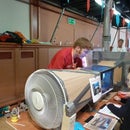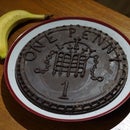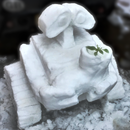Introduction: Turn Heat Into Noise - Make a 90dB Rijke Tube
Rijke tubes are a little known way of turning heat into sound without any moving parts. Better still you can make one using nothing but scrap. Below is an explanation of what they are and how they work, if you want to get straight onto making one go to the next step!
What are Rijke tubes?
Most noises you hear every day come from something that moves, whether that is a speaker, your vocal chords, the strings of a guitar, the skin of a drum, or your lungs blowing air into a wind instrument.
Instead, Rijke tubes use heat to cause a self oscillating effect caused by thermoacoustic amplification, which I will try to explain below. The noise generated is a very loud eerie pure tone, as you can hear in the video.
The tubes Pieter Rijke used to demonstrate his newly found effect in 1859 used a metal gauze that would be heated by flame and then make noise once the heat source was removed, until they cooled down. These would make noise for 10 seconds at a time. Instead we use an electric heating element to keep the sound going indefinitely.
How do they work?
A hot filament located a quarter of the way up the tube causes the air to heat up. Hot air rises, maintaining a convection current in the tube. When a sound wave of the right pitch enters the tube, it creates an increase in pressure in the tube. Air rushing in at the bottom slows as it pushes against this pressure. The slowing means this air receives less heat so the average temperature of the air in the tube cools a little. Cold air contracts lowering the pressure in the tube and sucking the air in faster. This causes more heating and a rise in average temperature, causing the air to expand, starting the cycle again.
All this happens at hundreds of times a second, making the eerie sound.
What determines the pitch of the note generated?
The sound is a pure single pitch that depends on the length of the tube, the tube is a half-wave resonator and so the sound generated has a wavelength twice as long as the tube.
Step 1: Selecting the Tube
The Rijke tube really only has two components: a tube and a heater:
Tube
Selection of the tube is critical for success.
Material
The tube must be made of a material that is not likely to melt or burn. An internal heat shield can be used to allow plastic tube to work (e.g. gas pipe) but I strongly recommend choosing a material that is happy at 400°C such as glass or metal.
Diameter
If the diameter is too small, the heater needs to provide higher density of heating. Given the limitations on how much nichrome will fit before shorting or obstruction of air occurs, the nichrome will need to reach a higher temperature. Diameters under 22mm will need to run at or near the temperature at which the nichrome will just burn out. The glass tube pictured was right on the limit, and the small chrome tube was found to be too small.
Conversely, if the diameter is too large, you will need a very powerful power supply to provide enough heat to run the Rijke tube at all. The largest tube we could run with our 300W power supply was 40mm.
We had best success using a 30mm diameter tube of stainless steel cut from a Henry hoover vacuum cleaner handle/stick.
Length
The length should be chosen based on the diameter to keep the length:diameter ratio between 10:1 and 18:1. We found the lowest power to achieve resonance for a given diameter was at a ratio of 14:1. The PVC tube pictured worked until we cut down the length, but no amount of power would make it sing once shortened (about 5:1) and we burned out the heater trying!
The tube is a half wave resonator, so if you are aiming for a particular note, cut the tube to half the wavelength of that note. Because we are adding heat, the speed of sound and therefore the frequency generated will vary slightly as the temperature changes, though ours was always within about 3Hz of nominal.
Step 2: Materials to Make the Heater
Once the tube is selected, the heater is what is left:
The heater is composed of three functional parts:
- Heater wire. You can use nichrome resistor wire from a spool, but this can also be harvested from scrap heaters in hair dryers, toasters or fan heaters. You could just use thin wire if preferred, or if you really want to get things hot, tungsten filament. The gauge (thickness) of nichrome used should be selected in combination with the length you can fit in the heater to ensure the voltage for a required current sits inside what your power supply can offer. Too much resistance means you will be limited by supply voltage, not enough and you will run out of current, just right and you can utilise the full output power of your supply :)
- Insulator to support the heater wire. I used mica sheet sold for jewellery making, but the reconstituted mica board found in hair dryers, toasters and the like is also suitable, and is used in the same function in these appliances.
- Wire to supply power. I used magnet wire, as the varnish used to insulate it is relatively heat resistant. Magnet wire can be bought cheaply, but is also available for free in scrap transformers or motors.
To run the heater you will need a powerful power supply. My smallest tube needed 80W, and our favourite 30mm diameter tubes ran at 100 - 125W. I also recommend a current limiting power supply to protect from shorts, especially if you are using a metal tube.
Step 3: Cutting the Mica
The mica needs to perform a few functions:
- Holding the filament densely in one place
- Stopping turns touching other turns
- Stopping turns touching the walls
...while:
- Allowing the air to flow up the tube
- Resisting the heat applied
- Isolating the filament electrically
I used a few different designs for the heater, but for the 30mm tubes I settled for two wraps of coiled wire around a cross of mica such that you get a tight spiral up the middle and then a wider spiral down the outside. The grooves were spaced to prevent contact between turns and deep enough to prevent contact with the walls of the tube. Each end I made holes to thread the magnet wire through to strain relieve the assembly, as I would later locate the heater by pulling it into position with the wires.
My best heaters were made by laser cutting the mica as this allowed the slots to be accurate, giving densest packing of filament as well as looking neater. Laser cutting wasn't needed though, as mica is easily cut with scissors or a sharp scalpel, and some of my earlier heaters were made this way (mostly single layer heaters). Holes can be drilled by turning a micro drill bit by hand gently cutting through the layers one after another.
Step 4: Wrapping the Heater Filament
In order to fit enough nichrome in to achieve the heating power required while doing it densely enough to work, I found it necessary to wind the nichrome into a tight coil before wrapping this coiled springy nichrome in a spiral around the mica. If you are using scrap nichrome, it might already be coiled as appliances often use coiled nichrome for the same reason of better power density. If not you'll have to wind the coil yourself...
I used a variety of mandrels to wind the coil including the wooded skewer pictured, and later I used the shanks of drill bits of various different sizes as it was easier to remove the filament from the slippery steel.
In order to maximise packing density of the filament, I wound a tight coil around a 1.2mm drill bit to use for the inner wrap and a looser coil wound around a 3mm drill bit for the outer wrap. I wrapped too much of each so I knew there was definitely enough.
When wound the coil is closed so needs stretching to open the filament. Then starting from the middle where the tight coil meets the loose coil wrap the tight coil by gently stretching it into each deep slot, moving it to the bottom of the slot before moving to the next. It is sometimes necessary to wiggle the wire up and down to pull the turns through the slot in order to keep the wrapping spiral taught (so that it doesn't move and touch something).
Once the end of the mica is reached, stretch out the coil to straight and cut the filament such that you leave a 20mm of excess and tuck this end through the hole and bend it to keep it hooked there. Visually inspect the inner spiral for deformation or shorts as it is easier to correct before the outer wrap is added.
Once happy, start wrapping the looser coil in the shallower slots. The springiness of the looser coil, combined with the shallower slots makes this much easier. You do have to be careful not to apply too much force though as it is easier to crack the mica with the leverage of the wider diameter. Once again, when finished, straighten, cut and hook in the end of the wire. The finished heater should look like the one in the picture.
Step 5: Attach the Supply Wires
To supply power to the heaters, I used varnished magnet wire. The insulating varnish can be removed at the ends by scraping with a hot soldering iron to allow electrical connection.
If I'm honest, attaching the wires to the nichrome was a faff. Soldering nichrome requires a heap of flux and a lot of luck. I found the most reliable way to get a connection was bead solder on the end of the magnet wire and then tightly bind the magnet wire in the nichrome. Applying solder over the top at least traps the nichrome even if it doesn't wet to it, and being bound on means there is good enough electrical contact. Other methods I tried on occasion included soldering properly (too difficult), crimping (too bulky) and tying (too fiddly).
Once attached, lay the heater assembly next to the tube 1/4 of the way up and lay the magnet wire along next to the tube. Crease the wire level with the end of the tube so that the heater can be positioned correctly once slid into the tube.
Step 6: Final Checks and Assembly
Thread the wires through the tube and pull them until the heater is almost inside. Now is the time to correct any issues with the filament. Perform a thorough visual inspection for shorts or filament sticking out that might touch the tube.
Once happy, apply current limited power to the wires. Gradually increase the current until you get a dull red hot glow (not too bright or it will burn out). Look for hot spots or dark spots that might indicate issues. If the heating is even(ish) then note the current being applied.
Try not to run the heater red hot for too long as it will oxidise and become brittle (see matt dark piece in the third photo). Assuming the tube isn't too blocked, the heater will run slightly cooler in use as the chimney effect creates cooling air flow so the glow current is normally about right. Disconnect power and allow the heater to cool.
Pull the wires and carefully guide the heater into the tube. Keep pulling it through until you get to the crease. Your Rijke tube is now complete :)
Step 7: Make Some Noise!
You are ready to go. Mount the tube in a clamp in a way that won't object to getting hot (e.g. clamp with cork jaws, or insulate clamp with heatproof paper, silicone or oven mitts). The very bottom of the tube will be the coolest part.
Put in some ear plugs. Turn up the current and wait ten seconds for it to warm up. You should now get a loud tone. If not, check that the voltage and current suggest the heater is still working. Try clapping your hands under the tube and listen for a ringing noise. Look through the bottom of the tube (not the top - you would burn your eye) and see if the heater is glowing. Try turning the current until you get a dull red glow. Hopefully it will be working now, if not you might have to pack more nichrome into the heater or choose a different tube.
While we had mixed success with the various designs we tried, hopefully the guidance on tube geometry and heater design should help you be successful. We showed several tubes at Derby Mini Maker Faire, including one made from the curved section of vacuum cleaner handle, so non-ideal geometries can be made to work.
Good luck making yours!
If you enjoyed this please vote for me.

Runner Up in the
Make Noise Challenge

Participated in the
Trash to Treasure Contest 2017

Participated in the
Make it Glow Contest 2016













